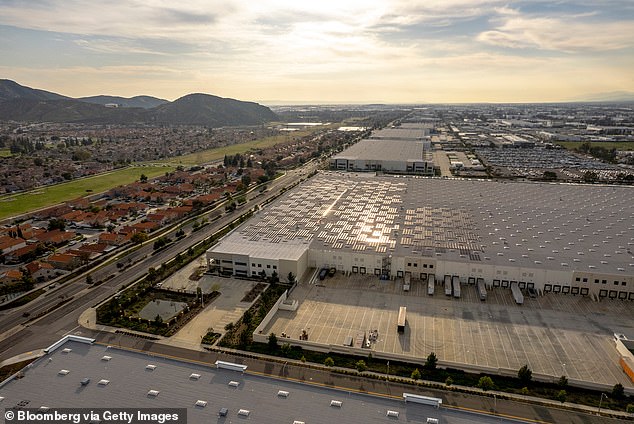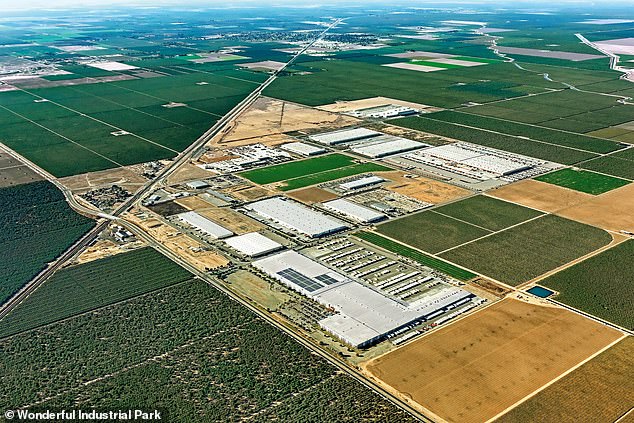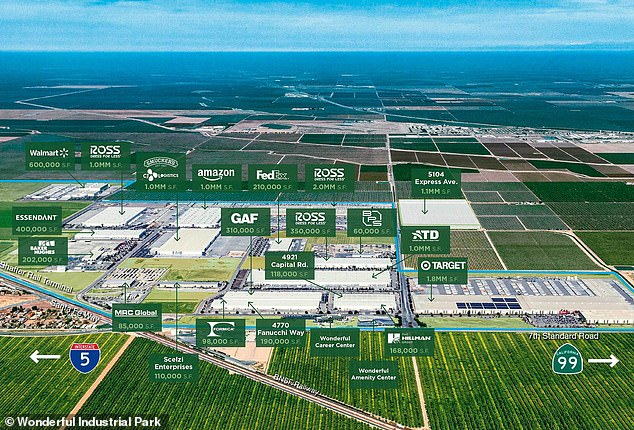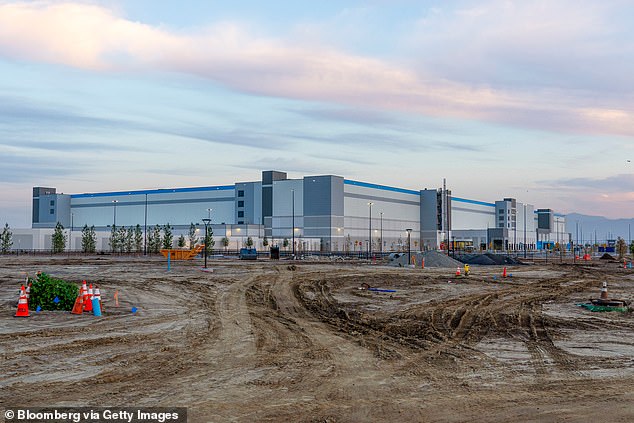How explosion of mega warehouses is turning America’s heartland into a hellscape, as raging locals say soulless eyesores are ruining their lives
In the tight-knit community of Bloomington, 60 miles east of Los Angeles, local residents have fought for years to protect their land, homes and health from the warehouse boom sweeping America.
They have watched anxiously as surrounding farms and agricultural lands have been swallowed up by sprawling industrial complexes, home to business giants like Amazon.
But it feels like they are fighting a losing battle. Soon, despite overwhelming local opposition, Bloomington Elementary School and hundreds of homes will be demolished to make way for a 213-acre business park. one of the largest warehouse projects in the region to date.
“We thought we could stop this through community involvement,” said a member of the activist group Concerned Neighbors of Bloomington. “It’s an industrial project in the middle of a neighborhood.”
The saga characterizes how the increase in self-storage space across America has come at the expense of local communities, who face the disadvantages of truck traffic and pollution to the loss of agricultural land.
In Pittsgrove, New Jersey, activists are fighting to prevent millions of square feet of warehouses from being built on tracts of rural farmland.

Warehouses next to homes in Fontana, San Bernardino County, California
In California’s Inland Empire region, the number of warehouses has doubled since 1993 to 4,000 units, covering 1.5 billion square feet.
A similar explosion is underway along the East Coast. In an industrial corridor of Pennsylvania and New Jersey that straddles the Delaware River, warehouse space has increased nearly tenfold since 2020 to 51.7 million square feet, according to an analysis.
Much of the growth has occurred since the coronavirus crisis hit and online shopping boomed during the lockdown, prompting companies like Amazon and Walmart to expand their next-day delivery services.
The largest warehouses can be as large as 1.5 million square feet, which is the equivalent of about 26 football fields.
These huge units that dominate the landscape can transform residential and rural areas into bustling logistics hubs, creating not only jobs, but also pollution and constant freight traffic.
Sections of pristine farmland have also been lost to towering warehouses that are reshaping the rural landscape.
In the Inland Empire, resistance to new development is led by the Center for Community Action and Environmental Justice.
‘Environmental injustices [of warehouse growth] – the impacts that disproportionately affect disadvantaged communities – have been ignored,” the organization said.
“This has resulted in exponential growth in warehouse infrastructure and related health issues impacting communities, workers, children and the elderly, creating a public health crisis in San Bernardino and Riverside counties.”
Amparo Muñoz, a former policy director at the group, said she started campaigning after an Amazon warehouse was built near her home in Fontana, a city next to Bloomington, in 2013.
She took a daily walk during pregnancy, but started having trouble breathing.
Thinking it was allergies, she consulted a doctor who told Muñoz she had developed asthma and said it was due to poor air quality. Her son was also born with asthma.

Much of the growth in warehouses has occurred since the coronavirus crisis hit and online shopping boomed, prompting companies like Amazon and Walmart to expand their next-day delivery services

The I-15 Logistics Center under construction in Fontana, California, USA, on Saturday, March 18, 2023
“Kids often wake up with nosebleeds on their pillows,” she told the LA Times. ‘We have the worst air quality. We have a stalemate. We have streets and communities that were never built for global logistics.”
The American Lung Association says San Bernardino County, home to Fontana and Bloomington, has some of the most polluted air in the country.
The recently approved Bloomington Business Park — which will see the demolition of Walter Zimmerman Elementary School and dozens of homes — was signed by San Bernardino officials in late 2022.
About a mile away, a replacement school will be rebuilt in a new location adjacent to the warehouse complex. But opponents say the environmental damage from the development poses a major health risk to schoolchildren and families living nearby.
The developers behind the project emphasize that it ‘creates an employment base and is an economic engine’.
A 2023 report from the influential Environmental Defense Fund found that 15 million people in ten states live within a quarter mile of a warehouse. The study looked at the ten states where warehouse construction has spread.
“Each warehouse generates hundreds, if not thousands, of truck trips every day, and trucks can emit more pollution while idling or traveling at low speeds than when traveling at higher speeds,” the report said.
‘Exposure to air pollution from these trucks is linked to a range of health problems, including the risk of developing asthma in children, heart disease, adverse birth outcomes such as preterm birth and low birth weight, cognitive decline and stroke.’
In Shafter, a small California town about 175 miles northwest of Bloomington, another battle is raging over plans to convert hundreds of acres of farmland into storage space.
Stewart and Lynda Resnick, the billionaires behind The Wonderful Company, already own a sprawling distribution center in Shafter.
Now they want to expand to create an international hub and position the province at the forefront of the global shift to online shopping. The move would convert 1,800 acres of Kern County’s almond orchards into additional storage space.
The development would transform Shafter from a small town of just 20,162 residents into a thriving commercial hub – and completely reshape the landscape around it.

In Shafter, another small California town 175 miles northwest of Bloomington, a fight is brewing again over plans to convert hundreds of acres of farmland into storage.

Stewart and Lynda Resnick, the billionaires behind The Wonderful Company, want to create an international hub in Kern County
Gustavo Aguirre, deputy director of the Delano-based Center on Race, Poverty & the Environment, told the LA Times: “I understand the company is saying it will create jobs. This is true to some extent.
“But it is also true that it will have health and environmental impacts that will impact the neighbors who live near the industrial park.”
Across the country in Philadelphia, several new warehouse projects are taking shape on unused brownfield lands, allowing developers to avoid some of the scrutiny placed on people in rural areas.
One such plan is to build fourteen warehouse buildings in South Philadelphia’s 1,300-acre Bellwether District, where an oil refinery once stood. According to Hilco Redevelopment Partners, the project will create more than 10,000 permanent jobs.
But new warehouses have also sprung up in rural areas across the region, including the Lehigh Valley.
CoStar data reported by the Philadelphia Inquirer shows that 64 warehouses were built or are under construction in the Lehigh Valley between 2020 and April 2024, totaling 23.5 million square feet.
Another 2.7 million square feet is planned in Lowhill Township, Lehigh County.
Campaigners in Lowhill claim this will lead to around 1,300 daily truck journeys on the area’s narrow country roads.
“The character of Lowhill Township will be significantly changed forever,” campaigner Sue McGorry told the Inquirer. “It will be destroyed.”

An Amazon fulfillment center under construction in Ontario, California, USA, on Friday, March 17, 2023
In Pittsgrove, New Jersey, activists are fighting to prevent millions of square feet of warehouses from being built on tracts of rural farmland.
“The reason Pittsgrove is still a beautiful place is because decades of dedicated work has gone into making it a beautiful place,” said Nicholas Mesiano of the Save Pittsgrove Campaign.
Save Pittsgrove recently held a protest rally at one of its locations, holding signs and t-shirts with the message: “No mega-warehouses.”
The promise of an economic boom for areas where warehouses are planned has also been tested in recent months.
Data shows that pandemic demand for space has declined – and in some cases even reversed, forcing some companies to vacate warehouse space.
In the Inland Empire, warehouse jobs fell in 2022 for the first time in decades.
Bloomington residents simply want the warehouses to remain far enough away from schools and homes to avoid health damage from environmental impacts.
“We are not against warehouses,” said a joint response to the Bloomington development from Senator Connie M. Leyva and Assemblywoman Eloise Gomez Reyes.
‘But we believe they do not belong right next to homes or schools where the health impacts would be most damaging and long-lasting for children and families.’
